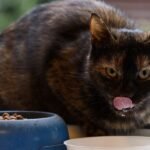Hi Carol Ann,
I appreciate you reaching out. I hope you’re doing well.
Dry stool can occur for a few different reasons. It’s the last part of the digestive tract, known as the colon, which absorbs moisture from the feces. The longer the feces stay in that location, the dryer it becomes. Supplementing the diet with oil will not ensure that the feces become more moist or lubricated. Instead, it would be ideal to try and determine the cause of this symptom.
If your cat is acting normal and appears healthy, you may not want to run off to the veterinarian for expensive diagnostics if this condition is not worsening. You could try a few different remedies to see if the issue improves. If there is an ingredient in the diet that is not being well digested, it could cause the transit of the feces to slow down. It could even create some inflammation within the gut which could interfere with proper digestion. It would be difficult to confirm this as it is usually explored by initiating different diet trials. However, you could consider starting a trial on a different diet with a different primary protein and carbohydrate and see if the issue improves. If you attempt this, I would change the diet very slowly over the course of 7-14 days and monitor the stool and your cat for any symptoms that suggest the diet is not ideal, such as diarrhea, vomiting, nausea, poor hair coat, lethargy, etc. It’s possible that a new diet with a different protein, for instance, could resolve an impaired digestive issue in your cat if it exists.
There are medical reasons that the feces can be dry as well. If the body has lower fluid levels and is dehydrated, then more water will be drawn out of the feces to try and rehydrate. This can occur when a cat has conditions that contribute to dehydration such as diabetes, kidney disease or any condition that can create dehydration in the body. For this reason, if the condition doesn’t resolve, I would recommend that you have a routine physical examination, consultation and wellness blood work and urine testing performed with your veterinarian.
If no conditions are found and a diet sensitivity is not discovered, it is possible that your cat has primary constipation. This is not uncommon in cats and can be a frustrating condition to manage over time. I would recommend that you allow your regular veterinarian to make the diagnosis before considering this as a confirmed condition. If you and your veterinarian come to this conclusion, here is a thorough review of the treatment strategies for primary constipation:
- Exercise. Like you mention in your question, exercise can help move things along the digestive tract. I should clarify that light exercise is good and that it shouldn’t be stressful or vigorous.
- Weight loss. We know that overweight cats are much more prone to constipation so keeping them at an ideal body weight will help prevent the condition.
- Diet. It’s ideal to control constipation through diet so that you don’t have to start administering medications or supplements. There are many prescription diets that are formulated to aid in preventing bulky dry stool and improve gastrointestinal health to reduce the risk of constipation. Diets with ideal finer levels and a low ash component will be beneficial for the condition.
- Encourage water intake. Water absorption from digested food occurs in the colon, so the longer feces sit in there, the more it will dry out and become firm, hard and difficult to pass. Increasing water intake in your pet by adding water to food, getting a water fountain, or flavouring your cat’s water bowl can encourage them to drink more. This will help prevent constipation.
- Stool softeners. There are products you can get from your veterinarian that will help soften the stool. Some of them are in a liquid form and some of them come as a powder. You may be able to find a sample of these in your pet supply store but I would recommend you speak to your veterinarian.
- Laxatives. There is a variety of laxatives you can use to treat constipation. In some cases you can use a human product that is over-the-counter. I always recommend speaking to your veterinarian before using any product on your pet and get his or her guidance.
- Fiber formulas. You can add fiber to your cat’s diet to reduce the risk of constipation and again, human variants can be used in some cases.
- Enemas. These should be performed by your veterinarian and they can be done in different ways. If the constipation is mild, a small amount of enema solution can be inserted into the colon through the anus. As the constipation worsens, large fluid mixtures can be used and even sedation may be necessary to alleviate a serious case. For the worst cases of constipation, a full general anesthetic may need to be performed and the stool can be physically removed.
- Pro-motility medications. There are drugs that will increase the ability of the digestive tract to propel digested food down through the colon. Speak to your veterinarian about the different products and dosages.
I hope some of this information helps. Good luck.
Dr Clayton Greenway








